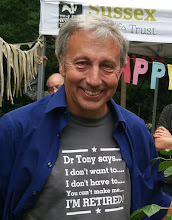On Sunday 5th July the Lewes Railway Land is
hosting the Biosphere Festival. There
will be a host of events and displays, including a small stand from the SWT,
but the event will be opened with a fascinating geological perspective on 500
million years of climate and sea-level change.
A geology display by Professor Rory Mortimore will be
formally unveiled at the Railway Land Festival. This display, which will
feature drilling cores, fossils, drone shots and QR code- triggered videos sets
out long term historical climate change that brings yet another aspect to the
pioneering Linklater Pavilion dedicated to the study of environmental change.
Said Professor Mortimore, who will open the exhibition at
3pm on 5th July, ‘Climate and sea levels have constantly changed
throughout geological time. The rocks
that make the South Downs record nearly 40 million years of environmental
change. Sea-level was 300 metres above present day (two times the height of
Beachy Head) when the Chalk, exposed in the river-cliffs at Lewes opposite the
Linklater Pavilion, formed.
The animals that lived in that sea and on the seafloor are
the fossils that we now find in our local chalk pits and shown in these
displays. As well as high sea levels the
Chalk represents a time when the Earth was a ‘hot-house’ with no or little
polar ice. Yet we can see in the Chalk
that there were also small ‘cycles’ of temperature and climate change
represented by the alternating beds of marl-limestone in Southerham Grey Pit.’
The free Railway Land Live! Festival, supported by the
Heritage Lottery Fund, will include many family activities - a Minecraft game
based on the Reserve, underwater wildlife images, a puppet show, displays by
the young sea level rise group of teenagers called the Linklater Rats, live
music, refreshments and much more. It
runs from 2-5pm at the Railway Land Local Nature Reserve, situated at the end of Railway Lane, Lewes BN7 2FG.
